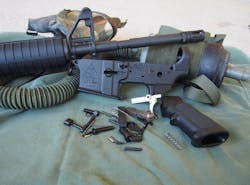Law enforcement officers are joining the ranks of hobbyists who build their own carbines. For law enforcement professionals, this is more than a hobby--it's a job skill.
The benefit is even more important: If I can build one, I can be proactive with routine maintenance and I can troubleshoot problems, even before they emerge.
The AR-15 is a unique firearm. It uses a relatively uncomplicated lower receiver that traditionally is made of aluminum. The lower receiver connects to the pistol grip and buttstock assembly. It contains the trigger group and magazine well. The lower receiver connects to the upper receiver by a couple of sturdy pins.
The upper receiver is also made traditionally from aluminum. The barrel and associated parts connect to the upper while the bolt carrier group, which contains the firing pin and parts that lock and unlock the chamber.
The design of the AR-15 is attributed to Eugene Stoner, although his design submission was the .308 AR-1 version. The concept was brilliant and Stoner earned a Mt. Rushmore place in the list of greatest firearm designers, alongside John Moses Browning, Mikhail Timofeyevich Kalashnikov and Gaston Glock.
The AR-15 uses an impinged gas system, where gases are bled from the barrel back to the bolt, through the carrier key part of the bolt. The gas pressure unlocks the rotating bolt during this portion of the cycle. This operation has advantages of reliability and fairly good accuracy.
Under General Curtis LaMay, the AR-15 was adopted by the Air Force as the M-16, which eventually led to it becoming the most recognized rifle profile in history.
Dave Dunlap, CEO of Precision Reflex Inc, and I were talking about General LaMay at SHOT. I mentioned I was working on an article on working on AR-15s (chuckling about the redundancy) and asked if there was anything readers should know.
Dunlap told me that a lot of surplus AR-15s have found their way into police agency inventories. They require careful inspection and working knowledge of parts compatibility.
Precision Reflex Inc is where I go for my scope mounts and an AR-15 product that is a game-changer: The M84 Gas Buster Charging Handle. This charging handle diverts hot gases away from the face of the shooter. It is a safety device used by the US Marines. For officers building the upper, this is especially important for officers with suppressed guns.For some reason, they kick back more gases.
Pick a Good Kit: Del-Ton
This past month, I built two AR-15 lower receivers and disassembled another. I built two of them while watching a couple of episodes of AMC’s Walking Dead. It doesn’t take long to build a lower. I do it for the same reason most law enforcement professionals should undertake this activity: I want control over the parts that go in my gun and I want to save money.
For this article, I picked probably the most cost effective AR-15 kits in the industry, a Del-Ton (www.del-ton.com). Based out of Elizabethtown, North Carolina, Del-Ton Inc. builds their complete rifles right out of their shop. They us quality US made parts and their customer service is top notch.
I guess I have to state the obvious here: I build Del-Ton guns because I can get a complete gun of good quality for half the price of most other manufacturers products. The product needs only a rear sight and it is patrol ready. Why not put an AR-15 into every patrol car in the agency?
Del-Ton Inc. sells complete rifles, but I like their rifle kits. The upper comes assembled and test fired. The lower comes ready to assemble. I usually put the lower together, the add my own “furniture”. Furniture is the term for easily-replaced forearms, pistol grips and buttstocks. My 16” Mid-Length Del-Ton kit came with a 1/7 twist barrel, round handguards and a 6 position stock.
This Del-Ton will eventually have the Mission First Tactical (www.missionfirsttactical.com) Battlelink stocks. This is the lightest stock on the market today and the foot has enough grip for the user to roll it from low ready to sighting plane smoothly.
Some Pointers
Building an AR-15 is particularly uncomplicated. It was designed to be easily repaired by replacing parts at the armorer level, rather than the gunsmith level.
The lower receiver contains only 30 parts. Most of us build the lower and purchase the already built upper. This is my recommendation for law enforcement agencies. Building uppers is not a hard undertaking, it’s just not as cost effective.
Years ago, I attended a Colt AR-15 Armorers Course, taught by Ken Elmore (www.specializedarmament.com). Ken described his pivotal incident during the Panama Invasion where a part failed in the middle of a mission. Ken related, “That day, I became an armorer.” Although I took this course more than a dozen years ago, those words stuck with me (and they are memorialized in my notes).
I recommend Elmore for your agency’s needs in training and consultation.
My online reference for AR-15 parts is the AR-15 Builder website from Brownells (www.ar15builder.com). For AR-15 fans like myself, it is the candy store. It’s set up for drag-and-drop building so users get a visual as they select their components.
AR15builder.com gives the user an idea what the components will look like when the gun is assembled. It does not check compatibility, however. For example, one can match a .308 receiver with a 5.56 upper on the site. They are incompatible, but it is assumed that the user has some working knowledge first. For an armorer working up a proposal for their agency, the proposed build can be saved and printed.
Midway USA is my other resource and I have been a customer of Midway for over 30 years. There are plenty of experts on the topic, but I always turn to Larry Potterfield. Midway USA has a series of videos hosted by founder and CEO Larry Potterfield. Simply go to the site and click on the links. There are separate links for building and upper and lower. This is better than any instructional I can give the reader on building an AR-15.
My method of building an AR-15 lower is exactly like Larry’s, except I have a few pointers. T here are several pins which require tapping in, using a brass hammer and a soft punch. The bottom of the receiver has two wings that tom the hinged portion of the trigger guard. Some users tap this in without supporting these wings. They break off easily, turning the receiver into metal sculpture.
I use an inexpensive arbor press, purchased at a discount tool place. I place a thin piece of wood between the wings and ease in the pin. A step up from that is the
Little Crow Gunworks AR-15 Trigger Guard Roll Pin Pusher which can be purchased at MidwayUSA. This pusher keeps everything aligned as one slowly inserts the pin.
Most first-timers tend to scratch their lower receiver a bit during assembly. I take a trip down to the local hardware store for ScotchBlue Masking Tape. This product is for masking surfaces when painting houses. When one removes it, the sticky stuff stays on the tape, not the protected surface.
Before assembly, I treat every piece of metal with generous amount of FrogLube. This will insure that things fit together smoothly. Before I apply the tape outside, I dry the surface. I test all of the pins to see if there are burrs in the channels in which they will eventually reside.
There are a few other tools that make AR-15 assembly easier. I recommend a detent pin installation tool. This is a steel rod the same diameter as the front takedown pin. It has a perpendicular hole drilled on on end. Rather than struggle with inserting the pin and spring, one inserts them through the drilled hole, then rotates the tool, trapping the detent pin. This is a timesaver that costs less than $5.
Another “must have” is a wrench that will remove the castle nut, the large cylindrical nut that locks the buffer tube to the receiver. There are multitools that work but I like the one I keep in my shooting bag (See What’s in Your range Bag? December 2013). It’s a Brownell’s Multitasker, a pocket-sized folding pliers-type tool with six AR-15 specialized tools. I built my second AR-15 build this month using only a Multitasker and some masking tape.
I recommend using a Spikes Block from Ergo Grips (ergogrips.net), a simple fixture that goes in the mag well. It is bolted to a table or similar figure while one works on the AR-15.
After I’ve done all of these things, I put on the Larry Pottinger Show and follow him step by step. I know I can do this all in my head. However, Larry has led me through lots of gunsmithing tasks for a long time.
After the Build
When I finished my Del-Ton, I packed up and went to the range. I sighted it in only a few rounds, but I recognized immediately a few things that I’m going to add. This is another thing Dave Dunlap and I discussed. I don’t like standard uppers with fixed front sights. The fixed sight is also where the gas tube resides. When one removes the sight, one must replace it with a gas block. I’ll probably add a PRI low profile gas block and a lightweight fore end.
The trigger provided with the Del-Ton felt pretty good for a standard trigger.
This gun did not like my reloads but it fed the DTTactical (doubletapammo.com) 55gr FMJ-BT cartridges flawlessly. I’ll be shooting some DTTactical cartridges for next month’s article. Let’s see what they can do at carbine ranges.
Sponsored Recommendations
Sponsored Recommendations
Build Your Real-Time Crime Center
March 19, 2024
Whitepaper: A New Paradigm in Digital Investigations
July 28, 2023
A New Paradigm in Digital Investigations
June 6, 2023
Voice your opinion!
Voice your opinion!



